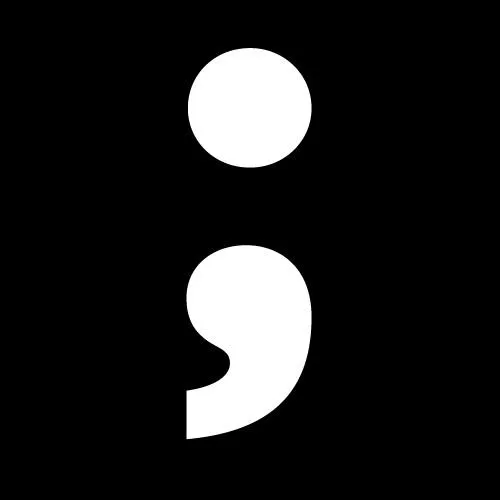Is the semi-colon semi-dead?

Too demure to be a colon but more assertive than a comma, the semicolon is a useful little tool.
Image: Supplied
Mark Lasswell
Like the fissionable atom, punctuation marks are wee items capable of causing a tremendous release of energy. Passionate disagreement over the use of exclamation points is so familiar that a “Seinfeld” plotline saw Elaine’s new romance with a writer blow up because he didn’t share her enthusiasm. F. Scott Fitzgerald, in the anti-exclaim brigade, famously said using them is “like laughing at your own joke.”
Tell that to Tom Wo!fe. Or just about anyone who texts in this angry age, when the exclamation point signals “I’m not fuming!” and a period can go off like a gunshot.
Apostrophes? George Bernard Shaw loathed ’em, often leaving the “uncouth bacilli” out of contractions, including didnt, wont and aint. Today, capricious apostrophe usage is so widespread (Its banana’s out there!), and meets with such predictable fury, that one suspects a vast prank-the-English-teachers campaign.
No piece of punctuation, though, stirs people up more than the humble semicolon. Too demure to be a colon but more assertive than a comma, the semicolon was introduced in 1494 by Venetian printer and publisher Aldus Manutius. What a useful little tool it has been in its primary role of inserting a graceful pause between two related independent clauses, as in: “RFK Jr. came to my house; he tore out the medicine cabinet with a crowbar.”
But now the semicolon is dead. Or semi-dead. Its use has collapsed, as underlined last month by a study from Babbel, an online language-learning platform. “Semicolon usage in British English books has fallen by nearly 50% in the past two decades,” the survey said - and this sudden drop followed a steady decline across the past two centuries.
A study of semicolon use in U.S. publishing from 1920 to 2019 saw a similarly dramatic slide. Newspapers, magazines, and fiction and nonfiction books all soured on the semicolon, though nonfiction after 2000 did see an uptick from the depths.
The Babbel analysis touched off a gratifying round of articles in the British press contemplating the semicolon. The Independent: “Our best punctuation mark is dying out; people need to learn how to use it”; the Financial Times: “Semicolons bring the drama; that’s why I love them”; the Spectator: “The semicolon had its moment; that moment is over.” (A secondary function for semicolons is to divide up unwieldy lists; a tertiary function is to help headline writers amuse themselves.)
On Team Semicolon, it turns out, we have Jane Austen, Charles Dickens, Mark Twain and possibly Abraham Lincoln. (“I have a great respect for the semicolon; it’s a very useful little chap” is a line attributed to Abe by a reminiscing journalist in 1878, which is to say: It sounds too good not to quote.) Virginia Woolf’s novel “Mrs. Dalloway,” the Guardian noted, employed “more than 1,000 [semicolons] to echo its hero’s flow of conscious thought.”
On the Not a Fan side, the flow of conscious thought hating on the semicolon is considerable. “Do not use semicolons,” Kurt Vonnegut advised in 2005. “All they do is show you’ve been to college.” George Orwell: “An unnecessary stop.” (Unnecessary but irresistible, apparently: He used plenty.) Cormac McCarthy: “Idiocy.”
Edgar Allan Poe wrote in an 1848 magazine article about being “mortified and vexed” by printers who substituted semicolons for the dashes in manuscripts. But a couple of paragraphs above that complaint, Mr. Nevermore himself used one, writing, “That punctuation is important all agree; but how few comprehend the extent of its importance!” Then again, maybe the printer just couldn’t resist.
Here’s New York Mayor Fiorello La Guardia delivering the keynote address at the 1935 U.S. Conference of Mayors: “We have developed a new kind of officeholder: ‘the semicolon boys.’ The semicolon boys are simply a boil on the neck of this administration - the fellows, you know, who have an office and some law school has graduated them. … They sit down and look for semicolons. … If they would only stop the typewriters, we could get the steam shovels working.”
When you have the Little Flower and Kurt Vonnegut, 70 years apart, agreeing that semicolon users are irritating, diploma-flaunting show-offs, what chance does the self-effacing little dot-over-comma have in these populist times? It’s a miracle the Trump administration’s threats to universities haven’t included making federal support for infectious-disease research contingent on the immediate cessation of all semicolon use.
But the semicolon will never completely go away, not as long as there are grown-ups around who still think punctuation emoticons are fun, using a ; and a ) to make a winking face and sending it to their teenage children, who are probably as mortified as Edgar Allan Poe. Maybe even vexed.